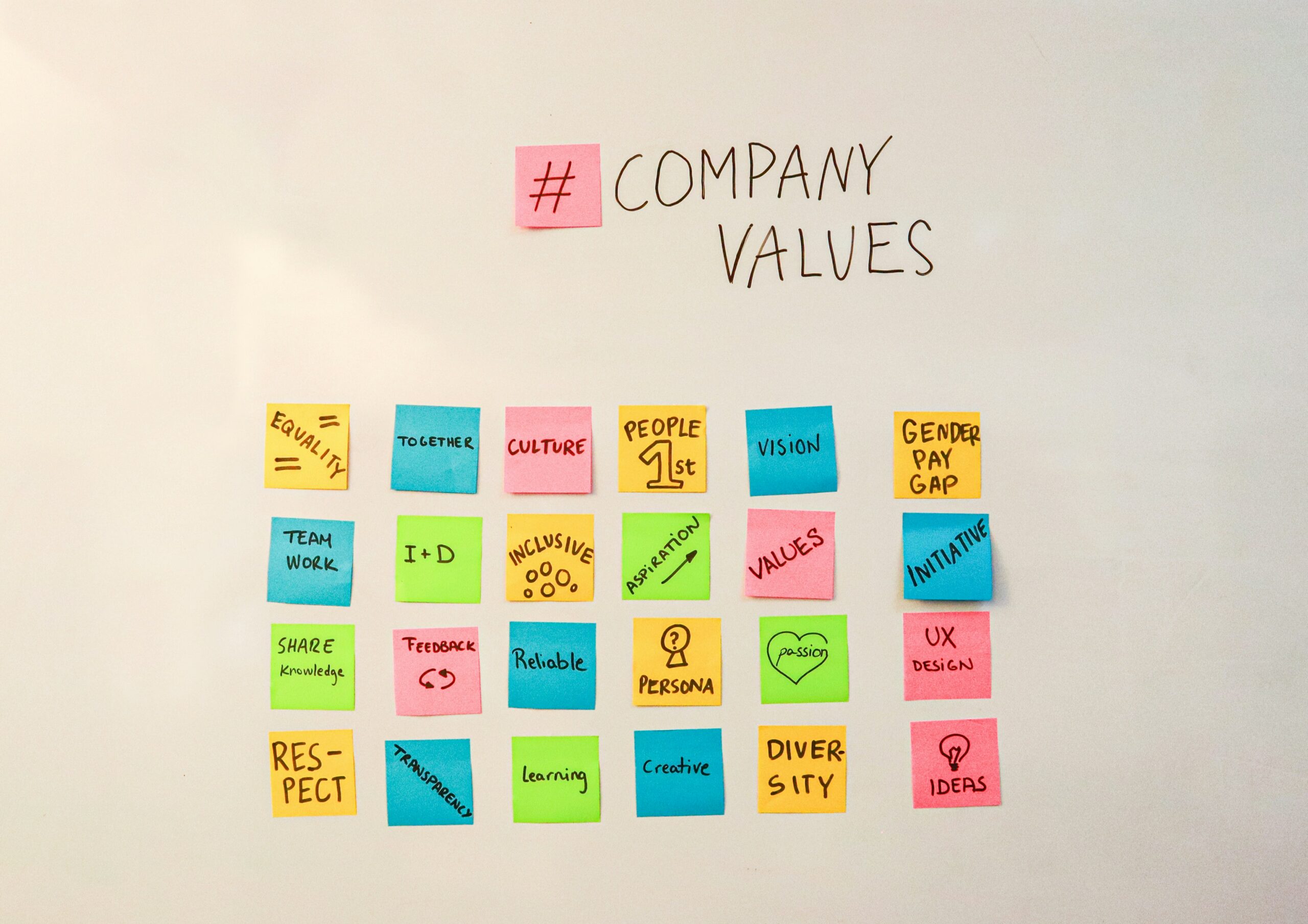At a pivotal moment for the future of work, companies can help their businesses and employees thrive

Employees have had more than a year to reflect on their needs and aspirations, and many want a new model of work. Our latest US Pulse Survey found that 65% of employees are looking for a new job. We also talked to executives, 88% of whom told us they are seeing higher turnover than normal.
For the most part, executives have a good grasp on why their employees are looking elsewhere. But when it comes to offering incentives that employees want most, they’re falling short in two key areas: benefits and compensation. This employer-employee tension compounds the challenge facing companies eager to redesign work. Rising inflation, the surging delta variant and tension over vaccines, masks and shifting return-to-work plans are creating extra uncertainty.
How can executives balance their strategic and operational goals with shifting employee expectations? Companies have a tremendous opportunity to transform work. By redesigning work, you can help drive growth, better anticipate uncertainty and create a workplace that top talent is eager to join. To successfully execute your plans, you’ll need to figure out your hybrid work model, make changes to processes and operating models, revamp strategic planning and, most importantly, attract and retain top talent.
Our survey offers insights into the changes executives are making as they redesign work and how they are centering many of those decisions around people.
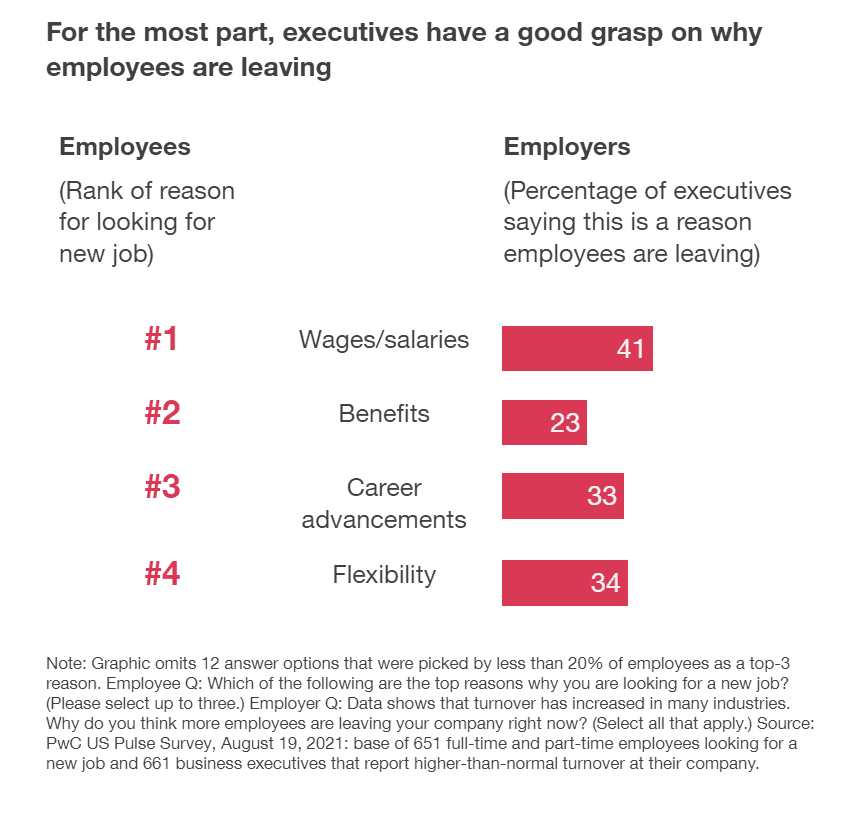
Other top findings:
1. Concerns vary across the C-suite as executives evaluate the impact of employee turnover. Nearly nine in ten (88%) executives we surveyed say their company is experiencing higher turnover than normal. That’s not surprising, given that the Job Openings and Labor Turnover Statistics (JOLTS) data from the US Bureau of Labor Statistics currently shows quit rates above pre-pandemic levels and continuing to rise. As of June 2021, the highest quit rates (which indicate voluntary turnover) are occurring in accommodation and food services (5.7%), leisure and hospitality (5.3%) and retail trade (4.1%). Other sectors are much lower, including education services (1.4%, not shown in the graph).
Inside organizations, executives are experiencing the ongoing labor market churn in different ways. CMOs, for example, are acutely feeling the negative impact of staff shortages on customer experience, with 40% citing it as a major issue. CHROs say retaining employees will be their number-one priority over the next three to six months. CFOs are split. Thirty-six percent say they’re very concerned about the turnover remaining high indefinitely and weighing on revenue growth. Another 45%, however, are somewhat concerned about turnover and its impact on growth, but they also expect it to return to pre-pandemic levels more quickly. Whether or not quit rates stabilize soon, employee expectations will likely continue to evolve in the foreseeable future, forcing executives to reconsider everything from where and how work gets done to new ways to make employees feel valued, included and motivated.
2. For employees looking for new opportunities, schedule flexibility, expanded benefits and compensation are top incentives. Companies on hiring sprees are refining employee value propositions, focusing above all on corporate purpose and leadership. While those are important, they should expect candidates to negotiate hard for what they now see as table stakes: competitive packages and perks coupled with flexibility and expanded benefits such as career growth and upskilling opportunities. Some may also see job changes as an opportunity to close pay gaps. Women are more likely than men to be seeking higher salaries (46% versus 34%). And more Hispanic and Black employees are looking (82% and 67%, respectively) compared to white/non-Hispanics (57%).
3. Good news for leaders: Efforts during the pandemic to build trust and step up on social issues are showing results with employees. Almost equal proportions of executives and employees agree that there is a high level of trust between leaders and employees—77% and 72% agree (34% and 35% strongly). Meanwhile, 79% of executives and 77% of employees say their leaders are inclusive (37% and 35% strongly agree). Leaders aren’t resting on their laurels, though, as inclusion continues to top the list of business priorities, especially as companies navigate hybrid work.
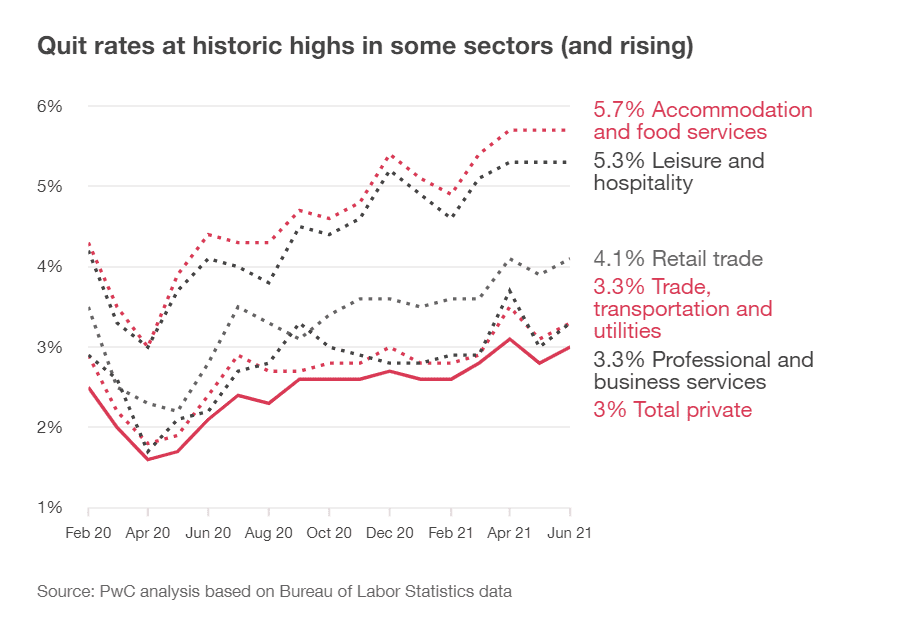
4. The challenge ahead lies in addressing culture, as companies define their work environments. Many executives are excited to return to an in-person environment, but an all in-person workplace is no longer the norm. The challenge for leaders: bringing out the best aspects of face-to-face teaming for all employees, whether in the office or not. A third of executives (33%) will have a mixed model, with some in-person full-time, some hybrid and some fully remote. They cite corporate culture as the biggest challenge to making hybrid work successful—36% say it’s a major challenge, and 36% say it’s moderate challenge.
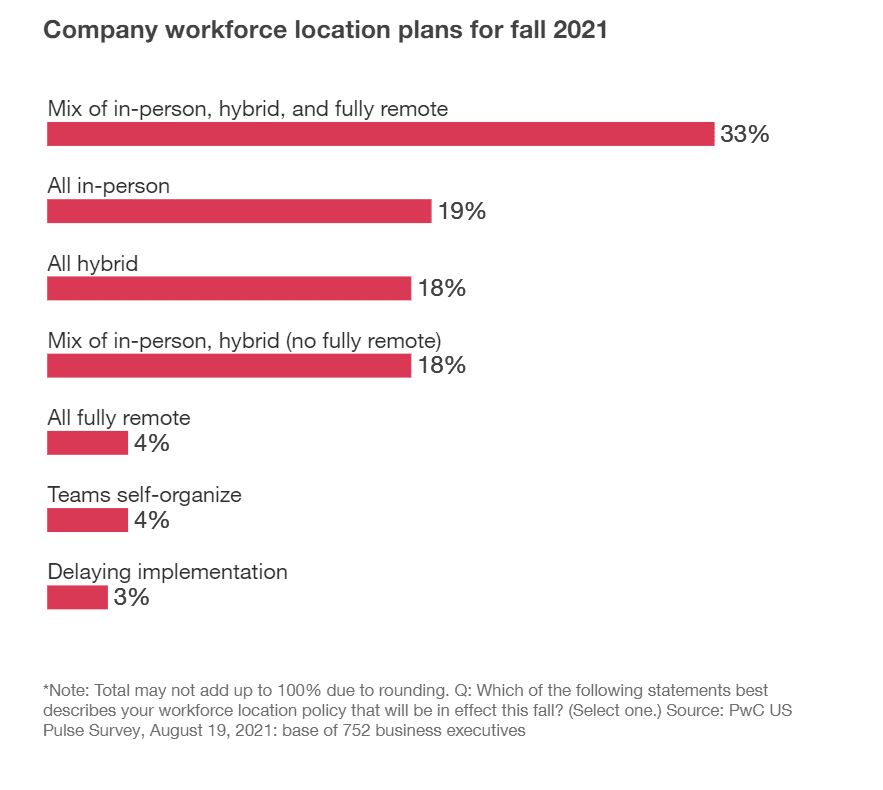
It’s a New Era, One That’s Focused on Hybrid and New Ways of Working
While some companies may be revising their reopening plans due to the surge in the delta variant and the plateauing of vaccination rates in some areas, their plans should still take into account the workforce’s growing embrace of remote work opportunities. Among employees looking for new jobs, almost one in ten say it’s because they moved away from the office while working remotely and don’t want to go back on-site.
Almost a fifth (19%) of all employees would like to be fully remote today, even if COVID-19 were no longer a concern. An almost equal number (22%) would like to be mostly in the office (<=1 day remote per week), and 21% say the nature of their work does not allow them to work remotely at all. Others prefer a hybrid work setup, with some days in the office and others remote.
When we zoom in on the subset of employees that we analyzed previously in our Remote Work Survey (those who were forced to work remotely during the initial shutdown in March 2020 plus those who were already working remotely before the pandemic), we can compare remote work preferences over time. Forty-one percent of those workers want to be fully remote in our current survey, compared to 29% saying the same in January 2021.
As executives face this new reality of hybrid work, concern about eroding corporate culture is the biggest challenge for executives (36%). Other reasons that may be holding companies back from expanding remote work options include loss of mentoring (30%), loss of innovation opportunities (26%) and potential equity issues between on-site and fully remote workers (25%). It’s a testament to the success of remote work that concerns about technology tools and cybersecurity measures have largely receded in comparison, though risk leaders remain concerned about cybersecurity issues related to remote and hybrid work.
Employers weigh vaccine mandates. Meanwhile, the expanding role of business in protecting the health and safety of employees is here to stay. Forty-four percent of executives say they’ll take a leadership role in encouraging employees to get vaccinated over the next 12 months. Only 30% percent strongly agree that their companies should implement vaccine mandates—perhaps sensitive to the anti-vaccination sentiment across sections of the workforce. Still, 36% agree and 20% say neither/nor or are unsure about the issue. Opinions could change quickly, though, as more and more companies announce vaccine mandates.
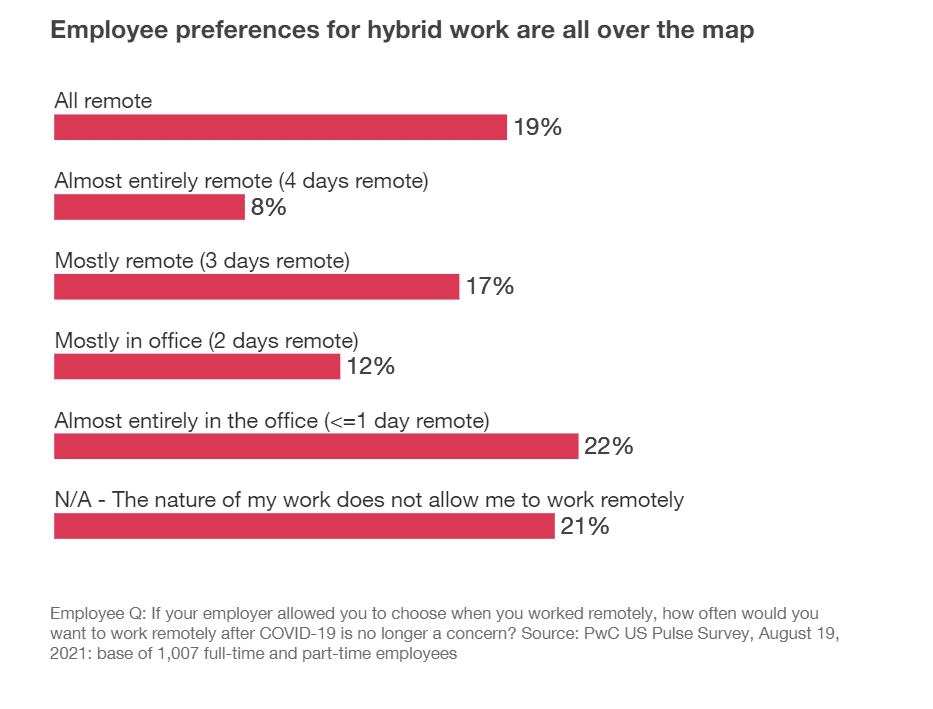
What Companies Can Do
Emphasize inclusive leadership to make hybrid models work
As hybrid models evolve, the focus should shift to creating a culture of inclusion and belonging for everyone that helps mitigate the risk of remote work inequity. Recognize that employees have different preferences about everything from where to work to how they feel about masks and vaccinations. For example, our survey shows that, while two-thirds of employees agree with vaccine mandates at work (32% strongly, 31% somewhat), around a quarter strongly disagree. Fewer employees—13%—in the Northeast strongly disagree, compared to 24% of employees in the South, 28% in the Midwest and 22% in the West.
Establish clear business roles around new ways of working
Be deliberate about how teams collaborate and how to replicate in-office culture for remote workers through new technology tools like virtual reality headsets or new meeting etiquette. Establish clear business rules in areas like safety protocols, and give people clear guidance on very tactical things like teaching meeting leaders to encourage participation from employees who aren’t physically present in the office. At the same time, don’t expect your employees to go back to more hierarchical ways of working. People will increasingly expect more choices and autonomy over their own schedules.
Companies are Reinventing Work with Strategic Planning, Operating Model Shifts and Enhanced People Experience
Companies are balancing changing workforce expectations with the strategic and operational shifts necessary to remain agile. We asked executives about strategic business changes they will make over the next 12 to 18 months. In a nod to the tight labor market, almost half (48%) will change processes to become less dependent on employee institutional knowledge. They’re also stepping up strategic planning around uncertainties like inflation, consumer confidence and government policy (41%). Over a quarter will also change their operating models, revise their location strategy and increase outsourcing. Tax leaders, for example, are digitizing their function through investments in cloud and automation and process redesign. And many COOs plan to reduce office space, change locations to leave cities or be closer to the talent they need, or move to a hub-and-spoke configuration.
Company initiatives around culture, value and purpose will be just as important for shaping the future of work, with almost half of business leaders saying those initiatives will differentiate them in a competitive market for talent. Their continued focus on these areas reflects the mainstreaming of stakeholder capitalism during the pandemic. More than half (57%) of companies are advancing diversity and inclusion (D&I) initiatives internally, and 42% plan to improve environmental, social and governance (ESG) reporting. These efforts have not gone unnoticed by workers. Over a third (35%) of employees say there’s a high level of trust between them and employers and that their leadership team is inclusive (compared to 34% and 37% of executives, respectively).
People want pay raises, flexibility, benefits and more. People scouting for new opportunities have their sights on more tangible rewards. Flexibility, benefits and compensation are nearly tied as the top incentives for employees. Companies are responding by putting more options on the table, especially schedule and location flexibility options. Around a third are also revising compensation, enhancing benefits and offering more career advancement opportunities. But so far, they are falling short of employee expectations.
What Companies Can Do
Prepare for the unexpected with rigorous scenario planning
The pandemic triggered many experiments in how people work. Now as the economy reopens, executives are moving from strategy to execution. More than a quarter (28%) of employees and executives strongly agree that they’re making permanent changes to how and where work gets done based on lessons from the pandemic. But with continued turbulence likely in the business landscape, robust scenario planning will be critical to redesigning work for the future as well as making sure business can be agile and move forward during periods of uncertainty. CIOs we polled are prioritizing data analytics to drive better decision-making about the future of work. Companies should use data to make decisions today, and be ready to calibrate and adjust as the environment shifts. More than half (58%) of directors say that employee turnover data is very important to their ability to oversee corporate culture.
Think beyond comp to entice employees
Take a holistic look at your benefits package and consider expanding the options and perks that are most in demand. Employees have been clear that they deeply value non-monetary benefits like expanded flexibility, career growth, well-being and upskilling. Reevaluate what you’re currently offering, drop what’s no longer relevant and add what’s important to employees now. Poll your employees to understand what they are looking for, and consider offering personalized options or à la carte benefits so employees have choices. A reimagined benefits package can be very attractive and a way to sweeten an offer.
Embed your workforce strategy into your business strategy
Be sure your people strategies go hand in hand with operating model shifts. For example, automating processes that employ minority workers may go against your D&I goals. Put in place robust governance and controls to confirm change programs are implemented without any breakdowns in quality. Step up communications and be transparent with employees and external stakeholders about how you are reimagining work and making progress toward that vision.
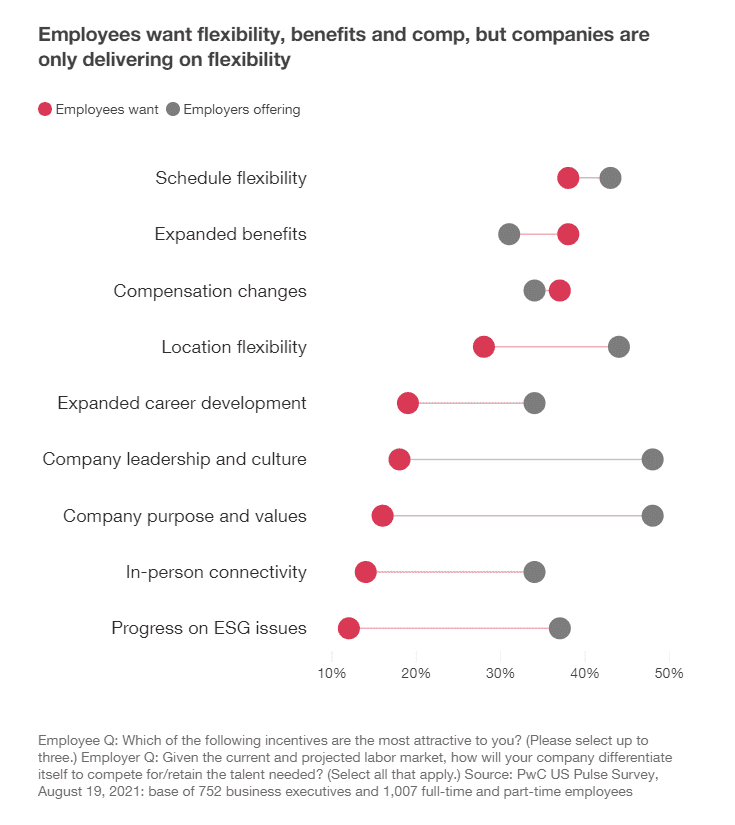

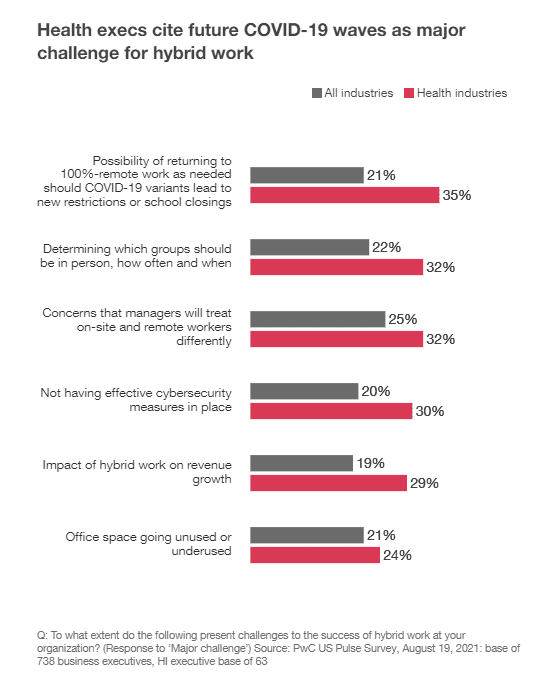
Health Leaders Can Build Workforce Plans that Recognize the Pandemic Burden on Employees
With a workforce that has been challenged both in creating life-saving vaccines and in caring for waves of COVID-19 patients, nearly a third of health leaders surveyed in our latest US Pulse Survey (32%) told us they strongly agreed that employee preference was the most important factor in developing their return to work plans, compared to 25% across all industries.
Health organizations are mostly looking at a mix of work locations for the fall, with 34% of those surveyed saying their workforce plans entail a blend of in-person, hybrid and remote. Another 22% say they’ll concentrate on hybrid. Certain health industry roles have less flexibility, as pharmaceutical manufacturing and clinical care in hospitals require on-site employees, but health leaders are finding areas where work can be done remotely, such as with back-office operations for insurers and health systems, and some R&D and commercial work by pharmaceutical and life sciences companies.
As they plan for the future of work, health leaders should consider that, while some employees are communicating that they want networking and connectivity with colleagues, that doesn’t necessarily mean they need (or want) to go back to on-site work full-time. Organizations may look at alternative ways to offer those experiences without the permanent expense of bricks and mortar.
As pharmaceutical companies compete with other industries for high-tech talent and as health providers face shortages of nurses, leaders in the sector also signaled support for offering schedule flexibility (43%) and location flexibility (40%) to retain and attract talent. Companies also may solidify relationships with employees through a focus on improving the employee experience, including their well-being and inclusive collaboration practices.
Health leaders indicated they plan to make strategic changes over the next 12 to 18 months in response to their experience during the pandemic, with 53% of executives surveyed saying they may revamp processes to make the organization less dependent on employee institutional knowledge. Companies should consider where automation and other digital investments may be best deployed.
For an industry that has been on the front lines of battling the pandemic, health industry executives surveyed also showed more interest in their companies having a vaccine mandate for employees than other industries, with 43% of health leaders in support compared to 30% across other industries. As variants come and go, further influencing perspectives on vaccines, health leaders should be prepared to organize their workforce to respond to the moment, or to create a more durable work model for the future.
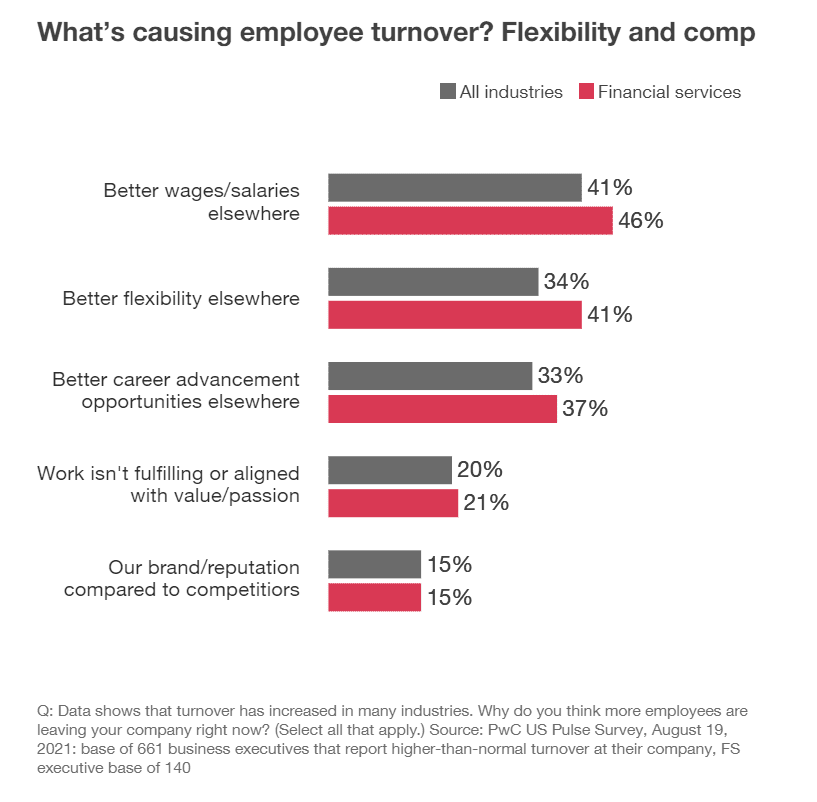
Financial Services Firms are Confident about Workforce Planning, but Risks Lie Ahead
Financial services (FS) company shares have been on a tear this year, outpacing the broader S&P 500 by 50%. It’s not surprising that industry firms have been upbeat about their pandemic responses. FS executives reported feeling positive about workforce planning and the return to the office. However, we’ve uncovered some trouble spots that could complicate recovery plans.
FS firms were frequently more optimistic about potential challenges to workforce strategy success than companies in other sectors. More than two-thirds (67%) of FS respondents said technology to support a hybrid work model would pose only a minor challenge, or none at all, compared to 52% of all respondents who said this. FS firms were more confident in other categories affecting hybrid work, too, looking beyond concerns such as a lack of effective cybersecurity measures to support remote work, ability to return to remote work if new restrictions emerge, unused office space, impact of hybrid work on revenue growth and other issues. Similarly, in nearly every category, they were less likely than average to report making strategic business changes based on their experience around working during the pandemic.
So far, so good. But with 83% of FS firms seeing more employee retention issues than before the pandemic, confidence may not be enough. When asked why turnover had increased, FS firms were more likely than their peers to cite better wages/salaries, better career advancement opportunities and better flexibility elsewhere, consistent with private conversations we’ve had with FS executives.
How will FS firms differentiate themselves to compete for and retain talent? Nearly half (49%) plan to emphasize schedule and location flexibility — and as we noted in Talent Strategies for Today’s Insurers, flexibility can be a game-changer for recruiting and retaining top talent. Still, only 27% plan to make compensation changes and only 31% plan expanded career development opportunities.
Financial firms have weathered the pandemic better than many expected, and many feel well-prepared if the situation gets worse. But some new threats lie ahead in today’s tightening labor market, so it may be time to pay more attention to what employees value most.
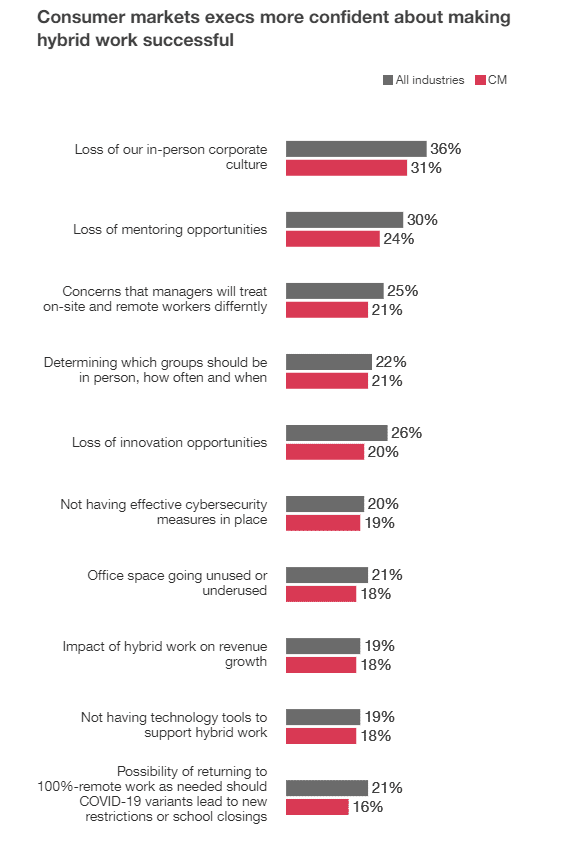
Consumer-Facing Companies Prioritize Purpose, Values
Adapting to keep pace with the massive shift online in 2020, consumer-facing companies ramped up digital investments in the wake of new customer expectations. Almost 80% have already initiated secure, effective virtual connectivity for remote work.
Now, as they make strategic decisions about the future of work, consumer markets (CM) leaders are building on those earlier digital investments to automate access to institutional knowledge regardless of whether employees are on-site or remote. They’re also shifting sales channels to accommodate customer behaviors forged over the past year.
Almost half (46%) anticipate a hybrid of on-site and remote workplace models later this year. CM companies were the most responsive to employee preferences in planning return-to-the-workplace strategies (71% versus 59% for all sectors).
Regardless, they’re facing the same high churn as all industries (88%). To compete for talent, more than 40% of CM leaders tell us they plan to offer greater location and schedule flexibility while emphasizing their company’s purpose, values, leadership and culture.
More than all other industries, CM companies draw heavily from local communities for both employees and customers, a limitation that’s been complicated by the pandemic. No surprise then that CM leaders report slightly higher levels of engagement with local governments and universities to address issues such as housing, safety and economic development than most other sector leaders.
In their planning, more than half of CM executives (54%) tell us their companies will embark on leadership mentoring programs for women and diverse populations. Meanwhile, 44% expect to improve reporting to stakeholders on issues such as pay equity, sustainability and diversity. Consumers have already indicated that these metrics affect buying decisions.
As employees settle into their new hybrid work environment, almost 70% of business leaders across all industries believe increased employee comfort levels will translate to consumer confidence, the lifeblood of CM companies and an essential component of economic growth.
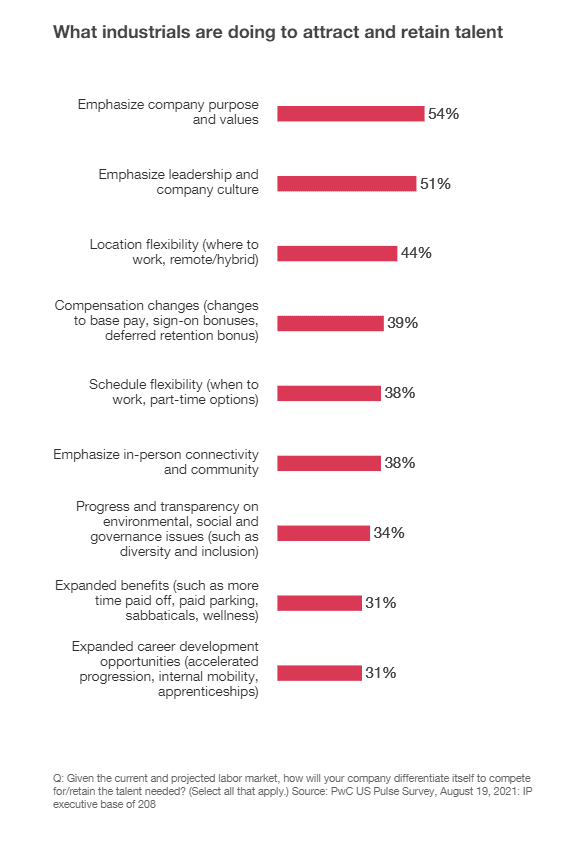
For Industrials, Hybrid Workforce Costing Innovation and Revenue Opportunities
Despite 14 consecutive months of manufacturing growth (as of July 2021), some manufacturers still face workforce strategy challenges in the wake of the pandemic. Roughly four in ten industrials expect their workforces will still be a mixed bag this fall, with some of their employees in-person full time, some hybrid and some fully remote. Just 16% have all workers on-site. For some, this has introduced persistent challenges, especially for those companies experiencing a pinch in their workforce that’s required to be in-person (e.g., factory-floor, warehouse and logistics roles). About a third of manufacturers attribute to hybrid work a loss of opportunities to innovate (31%) and a loss of mentoring opportunities (35%). Nearly a fifth (22%) agree that hybrid work’s impact on revenue growth is a major challenge, with 24% citing it as a minor challenge.
Looking out 12 to 18 months, hybrid work could bring strategic business changes, with 29% reporting that it could shift product and services mixes and over half (59%) agreeing that it could change processes such as automation and documentation to diminish dependency on institutional knowledge.
Although the US manufacturing workforce is steadily growing (adding 27,000 jobs in July), some industrials are nevertheless experiencing more employee turnover. They report that workers are leaving for a variety of reasons including better wages or salaries (41%), personal issues (28%) and that the work is not fulfilling or aligned with the employee’s values and passions (24%).
Given the sector’s perennial challenges in securing talent, industrials grasp the need to appeal to employees’ changing needs and expectations, especially after the personal and societal tumult created by the pandemic. In order to secure talent, industrials are looking beyond traditional recruitment and retention levers such as compensation, benefits and career opportunities. More than half (54%), for instance, are emphasizing company purpose and values and stressing leadership and company culture (51%).
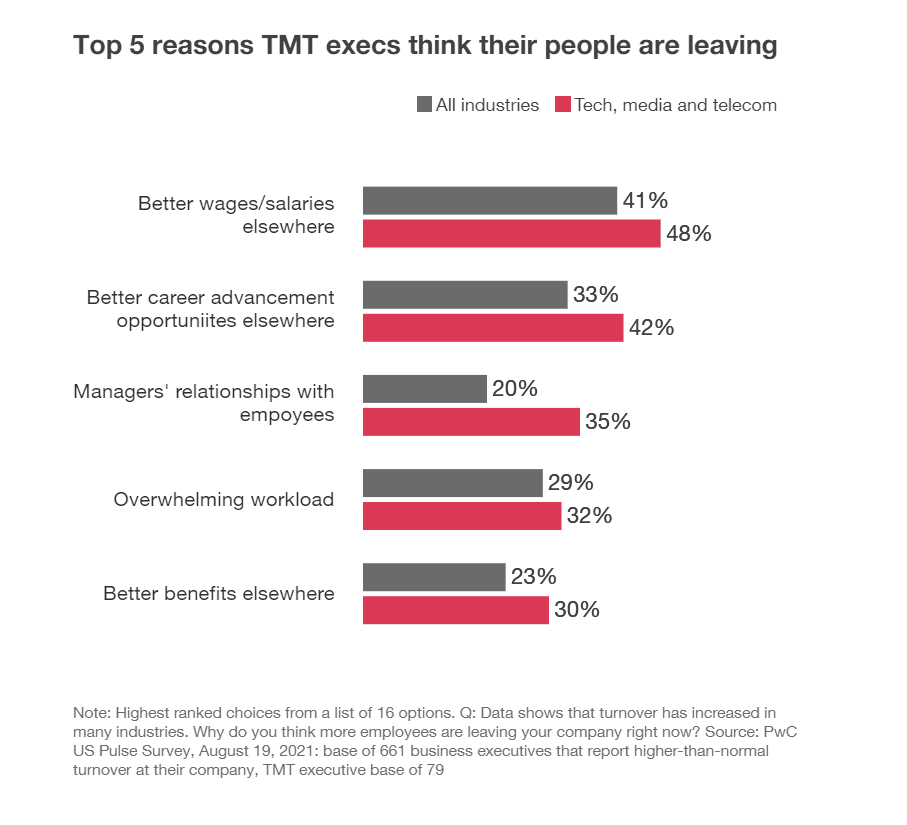
Hybrid Workplace has New-Product Implications for Tech, Media and Telecom Sector
For more than a year now, companies in the tech, media and telecom (TMT) sector have kept the economy humming by not only providing entertainment and connectivity but also providing the tools and security needed for remote work and education.
As COVID-19 variants complicate back-to-the-workplace timelines, the needs of a hybrid workforce across industries will have wide-ranging implications for innovation and new-product development at TMT companies. The challenge? Seizing these opportunities while also having to recruit and retain talent to achieve these goals.
In line with all industries, most TMT leaders (76%) tell us they’re concerned about sustaining corporate culture in a hybrid workplace environment at their companies, while more than 65% are concerned about loss of innovation and mentoring opportunities.
Competition for TMT talent is as fierce as ever, with more than 90% of TMT leaders reporting higher-than-usual turnover. In the wake of the pandemic, other industries are experiencing similar levels of employee churn.
More than other sectors, however, TMT workers are benefiting from the pandemic-related tech boom. They’re switching jobs for higher salaries (48% versus 41% overall), top-notch benefits (30% versus 23%), upgraded career advancement opportunities (42% versus 33%) and improved relationships with managers (35% versus 20%).
To compete for talent, TMT leaders are shoring up career development opportunities (47% versus 34% overall) and offering flexible schedules (49% versus 43%). They’re also expanding their geographic positions to target new talent, leveraging the hybrid and virtual processes learned over the past year.
Before the pandemic, TMT employees relied on a culture of in-person connectivity and interaction. Creating a similar hybrid workplace model will take thoughtful planning and implementation as employees seek to build productive relationships with colleagues, managers, mentors and direct reports. Looking to the year ahead, our survey indicates that advancing leadership mentoring programs for women and diverse populations will take center stage for 62% of TMT companies.
The experience of the past year has prompted TMT leaders to rethink the mix of products and services at their companies, adjust sales channels and assess location strategy as businesses and consumers employ an ever-increasing array of TMT products and services as they continue adapting to new ways of working and living.
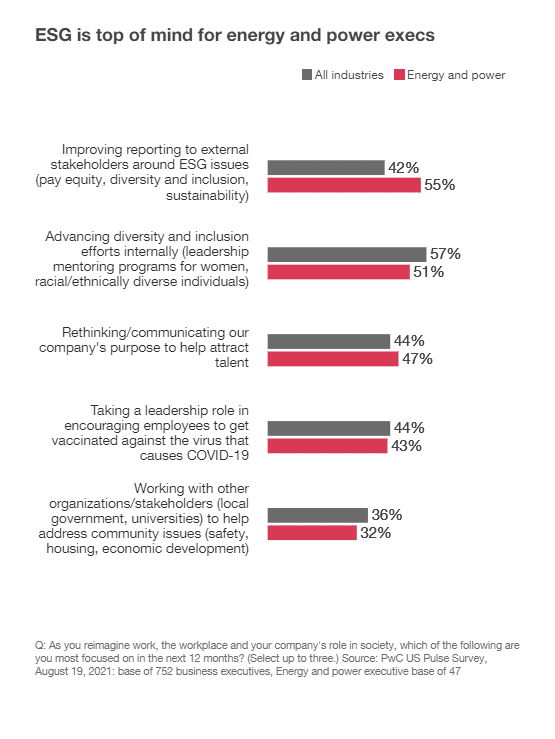
Energy and Power Leaders Say More In-Person Workers Needed to Achieve Growth Goals
Energy and power leaders face significant workforce strategy issues linked to a hybrid workforce, and the growing threat of the delta variant of COVID-19 may further exacerbate those challenges. Nearly half (47%) of energy and power companies currently have blended workforces, with some employees in-person full time, some hybrid and some fully remote. Just 21% of companies have all employees working in-person full time. Despite workforce strategies having been a moving target since the beginning of the pandemic, energy and power leaders are nevertheless ultimately intent on getting as many workers back in the workplace as makes sense, with 66% saying they need as many people on-site as possible to achieve their strategic growth goals. Toward that aim, nearly half of the industry leaders surveyed (45%) strongly agree that their company should carry out a vaccine mandate.
As a result of the hybrid workforce, some leaders cite major challenges they’re coping with, including the possibility of returning to 100%-remote work should COVID-19 variants lead to new restrictions or school closings (26%), loss of in-person corporate culture (34%) and concerns that managers will treat on-site and remote workers differently (38%).
Looking ahead over the next 12 to 18 months, industry leaders are focusing on strategic business changes founded on their workforce experience during the pandemic. These changes include revising processes (e.g., automation, documentation) to make them less dependent on employee institutional knowledge (55% report doing so), and 30% saying they’re making major revisions to their operating models.
While they’re eager to get more employees working in person, energy and power industry executives also face challenges of employee retention and recruitment as companies experience increasing rates of employee churn. Given the tight labor market, many are looking to differentiate their organizations through initiatives that go beyond conventional sweeteners such as more attractive wages or salaries and opportunities for advancement. For example, 43% will offer workplace location flexibility, and 40% expect that their progress and transparency on environmental, social and governance (ESG) issues could be a differentiating factor for current and prospective employees. In addition, 47% of respondents say their companies are rethinking their purpose to help attract talent.
Sector Implications
The article was first published here.
Photo by Tom Parkes on Unsplash.

 2.3
2.3 









